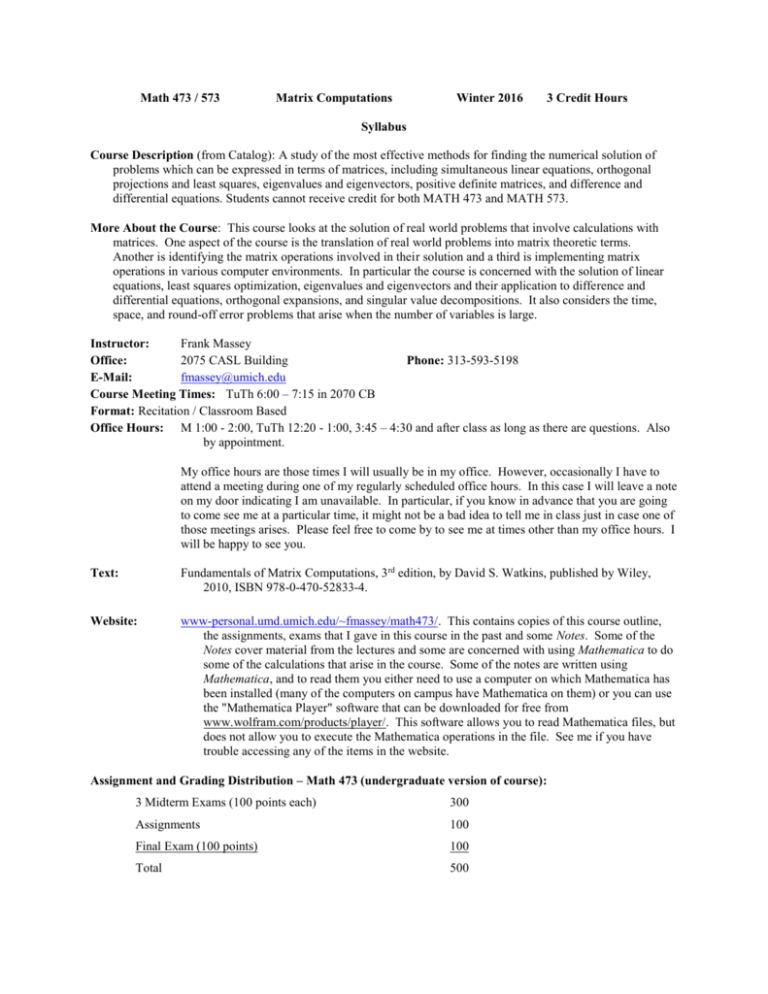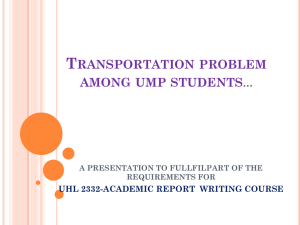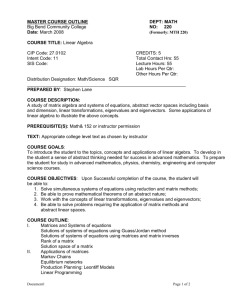Math 217 - University of Michigan–Dearborn
advertisement

Math 473 / 573 Matrix Computations Winter 2016 3 Credit Hours Syllabus Course Description (from Catalog): A study of the most effective methods for finding the numerical solution of problems which can be expressed in terms of matrices, including simultaneous linear equations, orthogonal projections and least squares, eigenvalues and eigenvectors, positive definite matrices, and difference and differential equations. Students cannot receive credit for both MATH 473 and MATH 573. More About the Course: This course looks at the solution of real world problems that involve calculations with matrices. One aspect of the course is the translation of real world problems into matrix theoretic terms. Another is identifying the matrix operations involved in their solution and a third is implementing matrix operations in various computer environments. In particular the course is concerned with the solution of linear equations, least squares optimization, eigenvalues and eigenvectors and their application to difference and differential equations, orthogonal expansions, and singular value decompositions. It also considers the time, space, and round-off error problems that arise when the number of variables is large. Instructor: Frank Massey Office: 2075 CASL Building Phone: 313-593-5198 E-Mail: fmassey@umich.edu Course Meeting Times: TuTh 6:00 – 7:15 in 2070 CB Format: Recitation / Classroom Based Office Hours: M 1:00 - 2:00, TuTh 12:20 - 1:00, 3:45 – 4:30 and after class as long as there are questions. Also by appointment. My office hours are those times I will usually be in my office. However, occasionally I have to attend a meeting during one of my regularly scheduled office hours. In this case I will leave a note on my door indicating I am unavailable. In particular, if you know in advance that you are going to come see me at a particular time, it might not be a bad idea to tell me in class just in case one of those meetings arises. Please feel free to come by to see me at times other than my office hours. I will be happy to see you. Text: Fundamentals of Matrix Computations, 3rd edition, by David S. Watkins, published by Wiley, 2010, ISBN 978-0-470-52833-4. Website: www-personal.umd.umich.edu/~fmassey/math473/. This contains copies of this course outline, the assignments, exams that I gave in this course in the past and some Notes. Some of the Notes cover material from the lectures and some are concerned with using Mathematica to do some of the calculations that arise in the course. Some of the notes are written using Mathematica, and to read them you either need to use a computer on which Mathematica has been installed (many of the computers on campus have Mathematica on them) or you can use the "Mathematica Player" software that can be downloaded for free from www.wolfram.com/products/player/. This software allows you to read Mathematica files, but does not allow you to execute the Mathematica operations in the file. See me if you have trouble accessing any of the items in the website. Assignment and Grading Distribution – Math 473 (undergraduate version of course): 3 Midterm Exams (100 points each) 300 Assignments 100 Final Exam (100 points) 100 Total 500 Assignment and Grading Distribution – Math 573 (graduate version of course): 3 Midterm Exams (100 points each) 300 Assignments 100 Project 50 Final Exam (100 points) 100 Total 550 Notes regarding Assignments and Exams: You may continue submitting solutions to the problems on the assignments until you have accumulated 100 points. 100 points is the maximum that your assignments may count toward your grade. The assignments can be found on CANVAS and at www-personal.umd.umich.edu/~fmassey/math473/Assignments/. Students taking Math 573 need to do a project where they find an article in a journal where the mathematics in this course has been applied to some other subject, submit a report on the contents of this article, and do something that extends what is done in the article. This will count 50 points. More details can be found at www-personal.umd.umich.edu/~fmassey/math473/Assignments/. See me if you need help finding a journal article to read and report on. The dates of the exams are on the schedule below. All exams are closed book, but a formula sheet will be provided. You may find that your calculator can do some of the problems on the exams. If this is so, you still need to show how to do the problem by hand, even if you use a calculator to check your work. There are several sources of problems that will help you prepare for the exams. First, there are the prior exams in the website. Second, there are the assignments. Finally, there are some problems in the text and notes that are listed in the schedule below. Work on these and ask for help (in class or out) if you can’t do them. A copy of the formula sheet is at www-personal.umd.umich.edu/~fmassey/math473/Exams/Formulas.doc. No make-up exams unless you are sick. I would like you to work by yourself on the exams and the assignments. See me if you need help. Grading Scale: On each exam and the assignments (and the project for Math 573) I will look at the distribution of scores and decide what scores constitute the lowest A-, B-, C-, D-. The lowest A- on each of these items will be added up and the same for B-, C-, D-. The lowest A, B+, B, C+, D+, D will be obtained by interpolation. For example, the lowest B is 1/3 of the way between the lowest B- and the lowest A-, etc. All your points will be added up and compared with the lowest scores necessary for each grade. For example, if your total points falls between the lowest B+ and the lowest A- you would get a B+ in the course. This information is in the file YourGrade which is located in the course website at wwwpersonal.umd.umich.edu/~fmassey/math473/. After each exam and assignment is graded this information will be updated and you should be able to see how you stand. You can find out what scores I have recorded for you by going to CANVAS, selecting Math 473 or Math 573 and clicking on Grades on the left. If possible, check your grades after each exam and assignment to see that they were entered correctly. Withdrawal: Wednesday, March 16 is the last day to withdraw from the course. 2 Dates 1/7 Section(s) W: 1.2, 8.1 N: 1.1 TENTATIVE SCHEDULE W = Watkins (the text) N = On-line Notes Topics and Suggested Problems 1. Solving linear equations. A. Applications to heat conduction, diffusion and approximating the solution of differential equations. Exam 1, W12 #1 1/12 W: 1.1, 1.3, 1.7 N: 1.2 1.4 1/14 W: 1.8 N: 1.5, 1.6 N: §1.1 Problems 1 - 6 B. Gaussian elimination, LU decompositions without pivoting, back substitution, time required. Exam 1, W12 #2 Exam 2, W12 #1 Let x and y be vectors with n components, A and B be mn matrices, and a number. Write algorithms using for loops to calculate the following: z = x+y, z = x, z = -x, = x.y (dot product of x and y), z = Ax, C = A+B, and C = A. B. (continued) LU decompositions with partial pivoting. 1/19 W: 1.2 Exam 1, W04 #1, 2, 5 Final Exam, W04 #1 C. Applications to electric circuits: Nodal analysis. 1/19, 21 N: 1.7.1 W: 1.8 Exam 1, W12 #3 D. Positive definite systems and Cholesky's decomposition. Exam 1, W12 #4 1/21 W: 1.2 1/21, 26, 28, 2/2 N: 1.7.2 W: 2.1 – 2.2 N: 2.1 – 2.5 2/2 2/4 2/2 2/9 2/11 2/16 W: 2.3 W: 2.6 N: 2.7 W: 3.2 N: 3.1 W: 3.1, 3.5 N: 3.2 W: §1.4 #1.4.21 (For part (a), use any method for finding the Cholesky decompostion that is convenient.) C. Applications to electric circuits: Loop analysis. Exam 2, W12 #2 2. Norms and error estimates. A. Propagation of errors in linear functions and when solving equations, norms of vectors and matrices, relative errors and condition numbers of matrices. Final Ex, W04 #6 Exam 2, W12 #3 Review for exam. Exam 1. B. Error in the solutions of linear equations due to errors in the coefficients. Final Ex, W12 #3f C. Propagation of errors in Gausssian elimination. 3. Least Squares Problems and QR factorizations. A. Projections on a line, reflections across a hyperplane, orthogonal sets and matrices. Exam 2, W12 #4 B. Least squares problems and reduction to the solution of linear equations. Ex 2, W04 #4 Exam 2, W12 #5 3 2/18 2/18 2/23 2/23 W: 3.2 N: 3.3 W: 3.3 N: 3.4 W: 3.4 N: 3.5 W: 5.2, N: 4.1, 4.2 2/25 W: 5.3, N: 4.4 – 4.6 3/8 W: 5.4, N: 4.7 3/8 3/10 3/15-17 3/22, 24 3/29 – 4/5 W: pp. 424 - 426, 433 N: 4.8 – 4.9 W: 5.5, N: 4.10 – 4.13 N: 4.14 – 4.16 Final Ex, W04 #3 C. Constructing QR factorizations using Householder triangularization. Ex 1, W04 #3 Ex 2, W04 #1, 2 Exam 3, W12 #1 D. Solution of least squares problems and linear equations using QR factorizations Ex 1, W04 #4 Ex 2, W04 #3 Exam 2, W12 #3 Final Ex, W04 #2 Final Ex, W12 #1 E. The Gram Schmidt process for QR factoriztion Ex 1, W04 #3 Exam 3, W12 #2 4. Eigenvalues and Eigenvectors. A. Review of eigenvalues and eigenvectors of a matrix, characteristic polynomial of a matrix, the powers of a matrix. Ex 2, W04 #5a Ex 3. W04 #2a Exam 3, W12 #4a, b Final Ex, W04 #5a B. Approximating eigenvalues and eigenvectors by power iteration, inverse power iteration and shifted inverse power iteration. Ex 2, W04 #5b, c, d Ex 3. W04 #2b, c, d Exam 3, W12 #4c, d, e Final Ex, W04 #5b, c, d C. The matrix of A in a different coordinate system, diagonalization, the Schur factorization. Final Ex. W12 #3 Review for exam. Exam 2. D. Approximating the eigenvalues of a matrix by simultaneous power iteration and the QR algorithm. E. Tweaking the QR algorithm so it runs faster: reduction of a matrix to upper Hessenberg form, the QR algorithm with a shift equal to the entry in the lower right corner, the QR algroithm with reduction of size. Ex 3. W04 #1 Final Ex, W04 #4 Final Ex, W12 #2 F. Adapting the QR algorithm for matrices with complex eigenvalues: properties of complex eigenvalues and their eigenvectors, powers of complex numbers, the eigenvalues of a 22 matrix, the GramSchmidt process with vectors whose entries are complex numbers, the QR algorithm with a shift equal to the eigenvalue of the 22 submatrix in the lower right corner which is closest to the entry in the lower right corner. 4 3/29 3/31 4/7 – 4/19 Ex 3. W04 #3 Final Ex, W12 #4 Review for exam. Exam 3. W: 4.1 – 4.2, 5.8 5. Singular Value Decompostions. A. Singular value decompositions of matrices, applications to image processing and least squares problems. Ex 3, W04 #4 Final Ex, W12 #5 4/19 Review for final exam. Tuesday, April 26, 6:30 – 9:30 pm. Final Exam. Mathematics Program Goals: 1. Increase students’ command of problem-solving tools and facility in using problem-solving strategies, through classroom exposure and through experience with problems within and outside mathematics. 2. Increase students’ ability to communicate and work cooperatively. 3. Increase students’ ability to use technology and to learn from the use of technology, including improving their ability to make calculations and appropriate decisions about the type of calculations to make. 4. Increase students’ knowledge of the history and nature of mathematics. Provide students with an understanding of how mathematics is done and learned so that students become self-reliant learners and effective users of mathematics. Course Objectives: After finishing this course students should be able to 1. Model situations in the real world with mathematical structures involving matrices, use matrix computations to analyze these problems and use the results of this analysis to answer questions about the real world situation. 2. Do matrix computations by hand 3. Use mathematical software to do matrix computations University Attendance Policy A student is expected to attend every class and laboratory for which he or she has registered. Each instructor may make known to the student his or her policy with respect to absences in the course. It is the student’s responsibility to be aware of this policy. The instructor makes the final decision to excuse or not to excuse an absence. An instructor is entitled to give a failing grade (E) for excessive absences or an Unofficial Drop (UE) for a student who stops attending class at some point during the semester. Academic Integrity The University of Michigan-Dearborn values academic honesty and integrity. Each student has a responsibility to understand, accept, and comply with the University’s standards of academic conduct as set forth by the Code of Academic Conduct (http://umdearborn.edu/697817/), as well as policies established by each college. Cheating, collusion, misconduct, fabrication, and plagiarism are considered serious offenses and violations can result in penalties up to and including expulsion from the University. Disability Statement The University will make reasonable accommodations for persons with documented disabilities. Students need to register with Disability Resource Services (DRS) every semester they are enrolled. DRS is located in Counseling & Support Services, 2157 UC (http://www.umd.umich.edu/cs_disability/). To be assured of having services when they are needed, students should register no later than the end of the add/drop deadline of each term. If you have a disability that necessitates an accommodation or adjustment to the academic requirements stated in this syllabus, you must register with DRS as described above and notify your professor. 5 Safety All students are strongly encouraged to register in the campus Emergency Alert System, for communications during an emergency. The following link includes information on registering as well as safety and emergency procedures information: http://umemergencyalert.umd.umich.edu/ Finally, all students are also encouraged to program 911 and UM-Dearborn’s Public Safety phone number (313) 593-5333 into personal cell phones. In case of emergency, first dial 911 and then if the situation allows call UM-Dearborn Public Safety. 6





